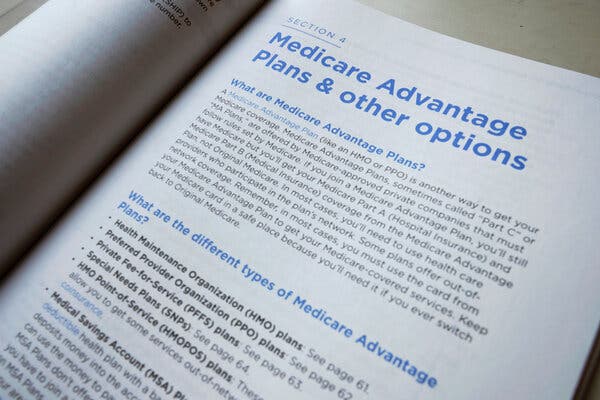Medicare — the federally funded health care program — has been in place since 1965. Since then, an expanding array of Medicare Advantage plans has become available.
In 2024, the typical beneficiary could choose from 36 Advantage plans that included prescription drug coverage; for 2025, they’ll face an average of 34. (A reduction isn’t necessarily bad; too much choice can be paralyzing, research has shown.)
Medicare Advantage plans, like traditional Medicare, are funded by the federal government, but they are offered though private insurance companies, which receive a set payment for each enrollee.
The idea is to help control costs by allowing these insurers, which must cover the same services as traditional Medicare, to keep some of the federal payment as profit if they can provide care less expensively.
The biggest providers of Advantage plans are Humana and UnitedHealthcare; they and other insurers market aggressively to persuade seniors to sign up or switch plans. A Senate report found that some companies’ practices were deceptive; for example, marketing firms have sent Medicare beneficiaries mailers made to look like government websites or letters.
Medicare has issued regulations to reduce the confusion. But the marketing blitz has paid off for insurers. The proportion of eligible Medicare beneficiaries enrolled in Medicare Advantage plans has hit 54 percent, an all-time high.
The programs operate quite differently, and the health and financial consequences can be dramatic. Each has, well, advantages — and disadvantages.
Jeannie Fuglesten Biniek, associate director at KFF, the health policy organization formerly known as the Kaiser Family Foundation, is a co-author of a recent literature review comparing Medicare Advantage and traditional Medicare. One important finding, Dr. Fuglesten Biniek said: “Both Medicare Advantage and traditional Medicare beneficiaries reported that they were satisfied with their care — a large majority in both groups.”
Advantage plans offer simplicity. “It’s one-stop shopping,” she said. “You get your drug plan included, and you don’t need a separate supplemental policy.” Traditional Medicare beneficiaries often buy such supplemental insurance, known as Medigap policies, to cover out-of-pocket expenses like deductibles and coinsurance.
Medicare Advantage may appear cheaper, too, because many plans charge low monthly premiums or none at all. Unlike traditional Medicare, Advantage plans also cap out-of-pocket expenses.
Next year, you’ll pay no more than $9,350 in in-network expenses, excluding drugs — or $14,000 with the kind of plan that permits you to also use out-of-network providers at higher costs (called P.P.O.s, or preferred provider organizations).
But the majority of Advantage plans don’t allow that choice. “Most plans operate like an H.M.O. — you can only go to contracted providers,” said David Lipschutz, co-director of the Center for Medicare Advocacy.
Advantage enrollees may also be drawn to the plan by benefits that traditional Medicare can’t offer. “Vision, dental and hearing are the most popular,” Mr. Lipschutz said. Many plans also include gym memberships, transportation or certain over-the-counter items, though some are now scaling back such extras.
“We caution people to look at what the scope of the benefits actually are,” he said. “They can be limited, or not available to everyone in the plan. Dental care might cover one cleaning and that’s it, or it may be broader.”
Most Advantage enrollees who use these benefits still wind up paying most dental, vision or hearing costs out-of-pocket.
One big disadvantage is that insurers require “prior authorization,” or approval in advance, for many procedures, drugs or facilities.
“Your doctor or the facility says that you need more care” — in a hospital or nursing home, perhaps — “but the plan says, ‘No, five days, or a week, two weeks, is fine,’” said David Lipschutz, co-director of the Center for Medicare Advocacy. Then you must either forgo care or pay out-of-pocket.
Advantage participants who are denied care can appeal, and in 2022 those who did had their denials reversed 83 percent of the time, according to an analysis by KFF. But only about 10 percent of beneficiaries or providers filed appeals, “which means there’s a lot of necessary care that enrollees are going without,” Mr. Lipschutz said.
A report in 2022 by the inspector general’s office of the Department of Health and Human Services determined that 13 percent of services denied by Advantage plans met Medicare coverage rules and would have been approved under traditional Medicare.
The Commonwealth Fund reported this year that Advantage enrollees were more likely to experience delays in getting care (22 percent) than those enrolled in traditional Medicare (13 percent), because of Advantage policies requiring prior authorization.
And 12 percent of Advantage beneficiaries couldn’t afford care because of co-payments or deductibles, compared with 7 percent of those with traditional Medicare.
Advantage plans can also prove problematic if you are traveling or spending part of each year away from home. If you live in Philadelphia but get sick in Florida, for example, all local providers may be out of network. Check to see how the plan you’re using or considering treats such situations.

“The big pro is that there are no networks,” Jeannie Fuglesten Biniek, associate director at KFF, formerly the Kaiser Family Foundation, said of traditional Medicare. “You can see any doctor that accepts Medicare,” as most do, and use any hospital or clinic. Traditional Medicare beneficiaries also largely avoid the delays and frustrations of prior authorization requirements.
But traditional Medicare sets no cap on out-of-pocket expenses, and its 20 percent co-pay can add up quickly for hospitalizations or expensive tests and procedures. So most beneficiaries either buy a supplemental Medigap policy to cover out-of-pocket expenses, or have supplementary coverage through an employer or Medicaid.
Medigap policies are not inexpensive; in 2023 they averaged from $191 to $267 a month, KFF reported.
A KFF literature review found that traditional Medicare beneficiaries experienced fewer cost problems than did Advantage beneficiaries if they had supplementary Medigap policies. But if they didn’t, Medicare beneficiaries were more likely to report issues like delaying care for cost reasons or having trouble with paying medical bills.
Traditional Medicare also provides somewhat better access to high-quality hospitals and nursing homes. David Meyers, a health services researcher at Brown University, and his colleagues have been tracking differences between original Medicare and Medicare Advantage for years, using data from millions of people.
The team has found that Advantage beneficiaries are 10 percent less likely to use the highest-quality hospitals, 4 percent to 8 percent less likely to be admitted to the highest-quality nursing homes, and half as likely to use the highest-rated cancer centers for complex cancer surgeries, compared with similar patients in the same counties or ZIP codes.
What’s more, some Medicare Advantage plans have narrow provider networks, compared with those available through traditional Medicare, Dr. Meyers and his colleagues have reported.
Some Advantage plans offer limited access to primary care doctors and to dialysis centers. Doctors who treat higher numbers of complex patients with greater social and medical risks are less available than through traditional Medicare.
Johns Hopkins researchers reported in 2023 that most Advantage plans also offered narrow networks of psychiatrists, enrolling fewer than a quarter of those practicing in a service area.
“Providers are starting to push back more on Medicare Advantage plans, and that leads to fewer providers — hospitals, doctors’ groups — willing to contract with Advantage plans,” said David Lipschutz, co-director of the Center for Medicare Advocacy.
Generally, patients with high needs — people who were frail, limited in activities of daily living or had chronic conditions — were more apt to switch to traditional Medicare, especially in the final year of life, than those who were not high-need, Dr. Meyers and his colleagues have found.
“When you’re healthier, you may run into fewer of the limitations of networks and prior authorization,” he said. “When you have more complex needs, you come up against those more frequently.”
Another downside to traditional Medicare, though, is that it does not include drug coverage. For that, you need a separate Part D plan.

Here’s where major policy shifts affecting Medicare Part D, which covers prescription drugs, make comparison shopping especially important in 2025.
Advantage plans usually include drug coverage; in traditional Medicare, you must buy a separate Part D plan. But the changes will affect both.
The most evident, through the Biden administration’s Inflation Reduction Act, is a $2,000 cap on out-of-pocket payments. “That’s a pretty big change in the level of financial protection it provides,” said Juliette Cubanski, deputy director of the program on Medicare policy at KFF, formerly the Kaiser Family Foundation.
Moreover, the law mandates that after beneficiaries reach the $2,000 cap, insurers must now pay 60 percent of remaining drug costs, up from 20 percent.
That means that “plans have stronger incentives to control costs,” Dr. Cubanski said. They are responding in various ways, increasing premiums or deductibles, reducing benefits and changing formularies, the lists of drugs that plans will cover.
A few companies have withdrawn from the market entirely. But Medicare protections will keep premiums from skyrocketing, at least for the next few years.
In 2024, beneficiaries could typically choose between 21 stand-alone Part D plans, at prices that ranged from $1 to $108 a month and averaged $43 for policies available nationwide, according to KFF analyses. In 2025, there will be 15 in most regions.
They typically have a annual deductible, $590 in 2025. You pay that amount out-of-pocket before coverage kicks in.
Then, a Part D plan, either stand-alone or as part of a Medicare Advantage plan, usually establishes five tiers of drugs with different coinsurance payments for each, from low-cost generics to brand names to high-priced specialty meds.
To keep consumer costs reasonable during this transition, Medicare has started a demonstration program for stand-alone Part D plans.
“The maximum premium increase people will see for stand-alone coverage is $35” per month, Dr. Cubanski said. If Medicare hadn’t taken action, “premium increases certainly would have been larger.”
Some plans will not increase premiums that much; some will charge less than in 2024. The demonstration program, which nearly all Part D insurers are participating in, will remain in effect through 2027.
Comparing plan formularies is always a complicated process. “Plans make choices about which drugs they cover and which they don’t,” Dr. Cubanski said.
Different plans cover different drugs (which can change from year to year) and place them in different pricing tiers. To make comparisons more dizzying, certain pharmacy chains are “preferred” by certain plans, so you could pay more at CVS than at Walmart for the same drug, or vice versa.
Because of the $2,000 out-of-pocket cap, formularies matter more than ever.
Consider the injectable weight-loss medication Wegovy, for instance. “If your plan covers it, you won’t pay more than $2,000” a year, Dr. Cubanski said. “If you’re enrolled in a plan that doesn’t cover that drug, you pay the full out-of-pocket cost,” which could exceed $15,000.
Next year will also bring the voluntary Medicare Prescription Payment Plan, offered by all Part D plans. It allows beneficiaries to pay their out-of-pocket drug costs in monthly installments instead of all at once.
Part D beneficiaries with diabetes should already be saving money on insulin, since last year Medicare began capping prices at $35 a month. Beneficiaries taking expensive drugs may save more in 2026, because Medicare now negotiates prices with drug makers.
It announced negotiated prices for 10 medications starting in 2026, with up to 15 more slated in each of the following two years, and up to 20 annually thereafter — another provision of the Inflation Reduction Act.
Most adult vaccines are free for Medicare beneficiaries.
You can, but be careful.
Switching between Medicare Advantage plans is fairly easy. But switching from traditional Medicare to an Advantage plan can cause a major problem: You relinquish your Medigap policy, if you had one. (Medigap is a separate insurance plan that covers out-of-pocket expenses like deductibles and co-insurance.)
Then, if you later become dissatisfied and want to switch back from Advantage to traditional Medicare, you may not be able to replace that policy. With some exceptions, Medigap insurers can deny your application or charge high prices based on factors like pre-existing conditions.
“Many people think they can try out Medicare Advantage for a while, but it’s not a two-way street,” said David Lipschutz, co-director of the Center for Medicare Advocacy.
Except in four states that guarantee Medigap coverage at set prices — New York, Massachusetts, Connecticut and Maine — “it’s one type of insurance that can discriminate against you based on your health,” he said.

You will find plenty of information on the Medicare.gov website, including the Part D plan finder, where you can input the drugs you take to see which plan gives you the best, most economical coverage. The toll-free 1-800-MEDICARE number can also assist you.
Perhaps the best resources, however, are the federally funded State Health Insurance Assistance Programs, where trained volunteers help consumers assess both Medicare and drug plans.
These programs “are unbiased and don’t have a pecuniary interest in your decision making,” said David Lipschutz, co-director of the Center for Medicare Advocacy.
But their appointments tend to fill up quickly at this time of year, and the annual open enrollment period ends on Dec. 7. Don’t delay.
